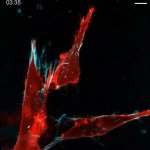
News • SARS-CoV-2 vs the proteome
Researchers explore coronavirus interactions with cells
Scientists from Würzburg and the US have charted the first global atlas of direct interactions between SARS-CoV-2 RNA and human host cells. This may provide a starting point for novel treatments. SARS-CoV-2 infections pose a global threat to human health and a formidable research challenge. One of the most urgent tasks is to gain a detailed understanding of the molecular interactions between the…


























